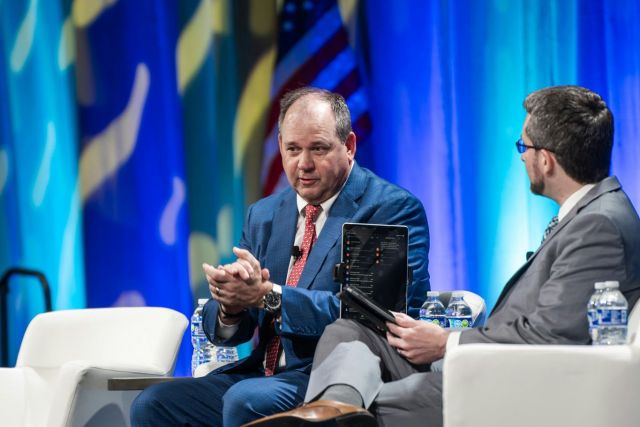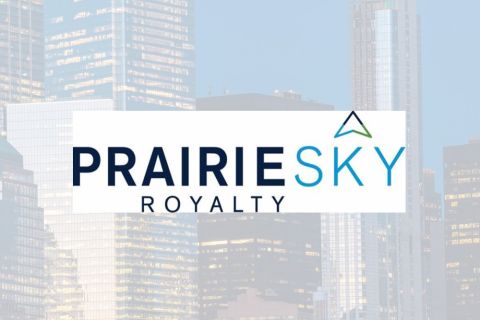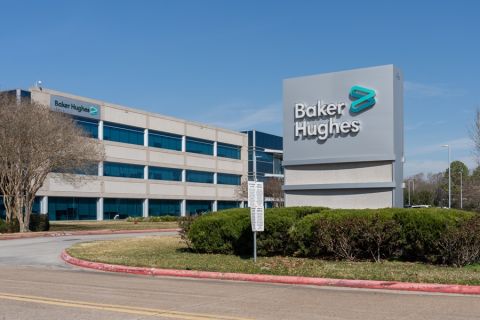
From left to right: John Christmann, CEO, Apache; Jordan Blum, editorial director, Hart Energy (Source: Hart Energy)
Fort Worth, Texas—Apache is taking actions and making no promises, focusing its exploration efforts where “we matter,” Apache CEO John Christmann said.
Speaking May 16 at Hart Energy’s SUPER DUG Conference & Expo in Fort Worth, he said that rather than making 2050 net zero promises, the company has been taking aggressive action, such as its decision made years ago to halt routine flaring in the U.S. and its program to replace pneumatic equipment.
“We're a company that wants to be seen as taking action,” he said.
Apache in April completed its acquisition of Callon Petroleum, which reshaped the company into a primarily Permian-focused player.
“It makes us now 75% Permian. 75% of our capital is going into the Permian,” Christmann said, noting the company will remain diversified through its international assets. “Now we're diving in and getting after it, and excited to demonstrate what we can do with the Callon assets.”
RELATED: APA Corp. Latest E&P to Bow to Weak NatGas Prices, Curtail Volumes
Christmann said plans are to develop the Callon assets with wider spacing and fewer wells per section.
“I think we understand landing zones and how you should develop multiple benches at one time. You'll see longer laterals … bigger fracs, and then on the production side, they're running a lot of ESPs (electrical submersible pumps” and doing gas lift, he said. “In the end, you've got one real shot at this, and you want to do it as efficiently as possible.”
He expects to run an average of 10 rigs this year in the Permian.
“We've actually taken a couple of the Callon rigs and moved those to Apache acreage because we know how we want to develop that,” he said. “The thing that's helped us more than anything is being able to align those rig programs with multiple quarters.”
Apache is in the business of testing concepts in the Permian “super basin,” Christmann said.
“We'll jump in, drill a few wells, test some concepts and if they work like you think they’ll work, you'll roll them out,” he said.
Places you matter
Having been an international company for three decades, Apache understands the benefits of diversifying its portfolio, Christmann said.
“We like to be in a few countries where we matter, and it's important that you matter to those countries,” he said.
Apache has been present in Egypt, which he called “a good investment,” for 30 years. Apache expects 13 rigs to 15 rigs to work its operations in Egypt’s Western Desert.
The company has also been exploring offshore Suriname. Together with partner TotalEnergies, Apache expects to reach FID on the Block 58 project, home to the Sapakara South and Krabdagu discoveries, this year with a target of first oil in 2028 or possibly 2027, he said.
RELATED: TotalEnergies Eyes Suriname FID by Year-end 2024
“We're in the process now of a FEED (front end engineering and design) study for what will be a large FPSO of 200,000 bbl/d,” he said.
He anticipates future projects in Block 58, and noted the fairway from Exxon Mobil’s Stabroek Block offshore Guyana maps right into Block 58 offshore Suriname.
“It’s been deemed the golden lane,” Christmann said. “Lots of resource there.”
Non-core assets
While Apache is largely focused on the Permian, Suriname and Egypt, it does have some assets that the company is not investing in, he said. However, the operator knows the value of those assets and will part with them for “the right price,” he said.
Those assets include some non-operating interest in the Permian and some areas in the Eagle Ford and Austin Chalks that may make more sense for other companies to invest in, he said.
They “may be better served in somebody else’s hands,” he said.
Maximizing with tech
“We've tried to be smart over the last 10 years with our workflows,” Christmann said.
The company has focused on data and modeling.
“We've got the capacity now to mine a lot more data and leverage that data,” he said.
Beyond automation, Apache is taking care of the cloud and technology to relieve some of the heavy lifting from its engineering team.
“Let the cloud do things a lot of your technical people used to do, used to pay engineers to look at and now we're able to let machines do it because it's really calculations,” he said. “It translates very well in terms of how to efficiently maximize your capital efficiency, which is ultimately what this is all about.”
Recommended Reading
Equitrans Midstream Announces Quarterly Dividends
2024-04-23 - Equitrans' dividends will be paid on May 15 to all applicable ETRN shareholders of record at the close of business on May 7.
PrairieSky Adds $6.4MM in Mannville Royalty Interests, Reduces Debt
2024-04-23 - PrairieSky Royalty said the acquisition was funded with excess earnings from the CA$83 million (US$60.75 million) generated from operations.
Baker Hughes Awarded Saudi Pipeline Technology Contract
2024-04-23 - Baker Hughes will supply centrifugal compressors for Saudi Arabia’s new pipeline system, which aims to increase gas distribution across the kingdom and reduce carbon emissions
EQT Declares Quarterly Dividend
2024-04-18 - EQT Corp.’s dividend is payable June 1 to shareholders of record by May 8.
Matador Resources Announces Quarterly Cash Dividend
2024-04-18 - Matador Resources’ dividend is payable on June 7 to shareholders of record by May 17.






